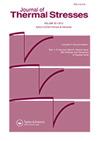Temperature-dependent vibrational behavior of bilayer doubly curved micro-nano liposome shell: Simulation of drug delivery mechanism
IF 2.6
3区 工程技术
Q2 MECHANICS
引用次数: 1
Abstract
Abstract This article analyzes the vibrational behavior of the double-layered micro-nanosphere to simulate the drug delivery mechanism in the biological structure under the influence of the temperature environment and the viscoelastic substrate for the polar lipid fraction E (PLFE) liposome isotropic material model. In order to obtain the micro-nano structural equations of the double-layer spherical shell, the displacement-strain relations of the shell have been expressed according to the first-order shear deformation theory and the non-local strain gradient theory. The partial differential equations of motion have been obtained by applying Hamilton’s principle. The system of linear couple equations have been solved using the Galerkin method. After validating the model with the results of the articles available in the literature to determine the accuracy of the presented model, numerical results are presented to investigate the effects of various parameters such as the radius of curvature ratio to length, damping coefficient, Kelvin-Voight damping coefficient, boundary conditions and temperature on vibration frequency response are provided and discussed. Results of the current research indicates that natural frequency decreases as the damping coefficient related to the viscous effect between the liposome bilayers increase. Results of the current research can be used as a benchmark for drug delivery applications.双层双弯曲微纳脂质体壳的温度依赖振动行为:药物传递机制的模拟
摘要本文分析了双层微纳米球在温度环境和粘弹性底物影响下的振动行为,模拟了药物在生物结构中的传递机制,建立了极性脂质分数E (PLFE)脂质体各向同性材料模型。为了得到双层球壳的微纳结构方程,根据一阶剪切变形理论和非局部应变梯度理论表达了球壳的位移-应变关系。应用哈密顿原理,得到了运动的偏微分方程。用伽辽金法求解了线性耦合方程组。在与现有文献的结果进行验证后,确定了模型的准确性,并给出了数值结果,研究了曲率半径与长度比、阻尼系数、Kelvin-Voight阻尼系数、边界条件和温度等参数对振动频率响应的影响。目前的研究结果表明,固有频率随着脂质体双层间粘滞效应相关阻尼系数的增大而减小。目前的研究结果可以作为药物递送应用的基准。
本文章由计算机程序翻译,如有差异,请以英文原文为准。
求助全文
约1分钟内获得全文
求助全文
来源期刊

Journal of Thermal Stresses
工程技术-力学
CiteScore
5.20
自引率
7.10%
发文量
58
审稿时长
3 months
期刊介绍:
The first international journal devoted exclusively to the subject, Journal of Thermal Stresses publishes refereed articles on the theoretical and industrial applications of thermal stresses. Intended as a forum for those engaged in analytic as well as experimental research, this monthly journal includes papers on mathematical and practical applications. Emphasis is placed on new developments in thermoelasticity, thermoplasticity, and theory and applications of thermal stresses. Papers on experimental methods and on numerical methods, including finite element methods, are also published.
 求助内容:
求助内容: 应助结果提醒方式:
应助结果提醒方式:


